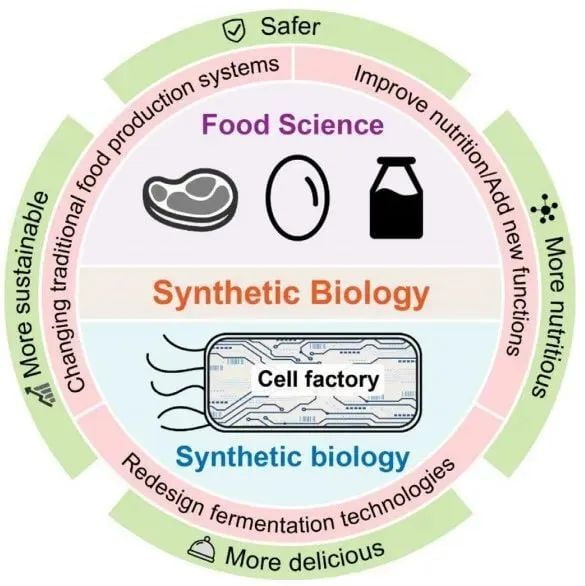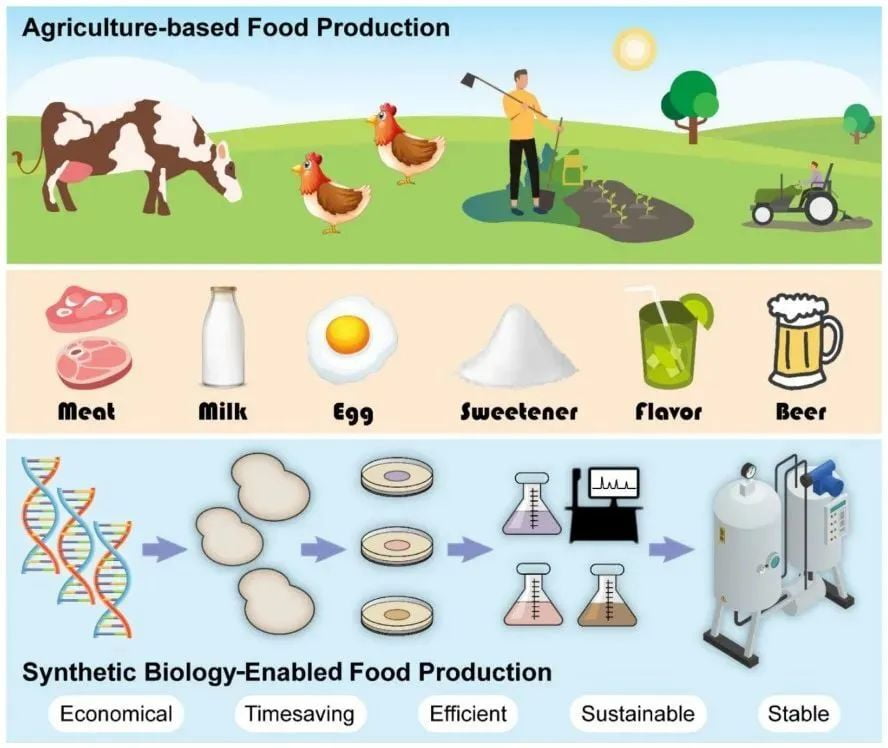As a core disruptive technology leading the industrialization of biotechnology, synthetic biology has become one of the strategic emerging industries and has shown great potential for application in chemical, agricultural, medical and food fields.
Replacing chicken houses, barns, and grasslands with bioreactors where food emerges not from the farm but from the lab? It sounds a bit unbelievable, but it has become a reality because of the advent of synthetic biology.
Food, as the energy-supplying substance for human cellular metabolism, is essential to sustain our daily life. In addition to conventional plant and animal food sources, there are foods manufactured by microorganisms, such as typical fermentation products: bread, wine, beer, and soy sauce, among others. In recent years, the development of synthetic biology technologies has contributed to a revolution in food technology.

The role of synthetic biology in the food industry
Shaping the future of food
Climate change, population growth, and plummeting agricultural land are affecting the human diet, and foods made by synthetic biology are changing the way people think about food and driving rapid growth in the field. The growing potential of synthetic biology in the field of functional foods, such as the use of microorganisms (e.g. yeast, bacteria or enzymes) to ferment specific food molecules and produce animal-based foods such as meat, dairy products or even breast milk, in a process that does not involve animals at all, gives us a glimpse of even more possibilities for the future of food.
For specific applications, synthetic biologists first modify foods by identifying the sequence of genes responsible for certain desired qualities, such as the beefy taste of beef or the sweetness of sugar, which are then chemically regenerated in the laboratory and placed in yeast or bacterial cells, and finally produce these proteins by fermentation, which will be applied as food or fiber ingredients in product formulations.
For specific raw materials, most current production methods rely on long growing cycles and low yield extraction processes, and in most cases the concentration of active compounds in the plant is relatively low, resulting in high prices across the market. At the same time, the raw materials are easily affected by the climatic environment and seasons, resulting in a less stable production supply chain. For example, synthetic vanilla now accounts for 85% of the global supply, solving a long-standing supply challenge for a spice that is primarily produced naturally in Madagascar. The emergence of synthetic biology technology has an important role in the accessibility of raw materials and supply chain security, among others.
Green and friendly to the environment
The emergence of synthetic biology technology has an important role in green and low carbon production, etc. In the case of artificial meat, it can reduce greenhouse gas emissions by 80% in the same production process compared to meat produced by traditional animal agriculture. By eliminating the need for space and diet for poultry farming, the production of the same weight of cellular meat can reduce land as well as fresh water by 99% and 96%, respectively.
In addition, in general broiler farming, it takes as fast as 40 days to produce a chicken, while the production cycle of cellular meat is shortened by 20 times, which means that the equivalent amount of chicken meat is available in just two days. It can be said that the method of biosynthesis has greater advantages in terms of economy, environmental protection, efficiency and scale. It is worth mentioning that meat and dairy products produced by synthetic biological methods are getting closer to the taste and appearance of traditional animal origin.
In addition to artificial meat, in traditional beer brewing, the flavor of beer relies on the aroma of hops, which is missing in non-alcoholic beer, and intensively grown hops consume a lot of water in the growing process and emit a lot of CO2 during transportation and processing.
In response, EvodiaBio, a Danish synthetic biology startup, uses engineered yeast to produce aroma molecules from hops, creating a non-alcoholic but flavorful beer that significantly reduces carbon emissions and water consumption in the production process.
Synthetic foods that have landed
Synthetic biology empowers the food industry to enrich categories and meet diversified health needs. It can develop high value-added functional foods, including carotenoids (lycopene and astaxanthin), human milk oligosaccharides (HMOs), vitamin K2, cannabidiol (CBD), superoxide dismutase (SOD), stevia, etc., to achieve the precise blending of nutrients to meet the health needs of specific consumer groups, and is an upgrade and innovation of the original health industry.

Synthetic food to increase production
Synthetic Meats
The advent of synthetic biology has enabled meat analogues to mimic real meat in terms of appearance and characteristics such as color and flavor, thus meeting the growing consumer demand for quantity and quality of food. Synthetic meat includes plant meat produced from plant proteins, cultured meat from animal cell cultures, and other meat analogs produced from sustainable proteins (e.g., algae and fungal proteins). Plant-based meat is synthesized using soy, wheat, peas, etc., but lacks real meat flavor. For this reason hemoglobin is often added to plant meat and hemoglobin production can again be synthesized using cell factories; cultured meat, also known as in vitro meat, is obtained by proliferating embryonic stem cells or muscle tissue from animals in bioreactors and then using scaffolds or microcarriers to obtain specific muscle fibers and bulk tissue. To meet consumer demand for taste and flavor of meat, fatty acids, aromatic molecules and other ingredients are then added.
Animal-free bioengineered milk
Milk is a very common food in daily life with a large consumer market and can also be synthesized using synthetic biology techniques. The main components of milk, whey protein, casein, etc., are first cultured using E. coli or yeast cell factories, and then the purified proteins are mixed with water, fat and other components (oligosaccharides, vitamins, etc.) to make synthetic milk. Such a dairy production method will revolutionize traditional livestock farming by avoiding land occupation while having the advantage of being free of antibiotics and hormones.
Low (zero) calorie sweeteners
A range of health problems, including obesity, diabetes and cancer, are linked to excessive sugar intake in the diet, so low-calorie or even zero-calorie sweeteners meet the public's needs. Such sweeteners are generally natural ingredients such as Ru-erythritol, and the use of synthetic biology can replace traditional plant extracts with cell factory production. There are also some common fragrances such as limonene and vanillin that can be produced by engineered cell factories.
Alternative Protein
With microorganisms as bio-manufacturing carriers, the future shows strong momentum in artificial milk, microbial bacteriological proteins, nutritional supplements, flavor substances, etc. Alternative protein products tend to have high added value, low market demand and high requirements for product purity.
High value-added proteins: Milk proteins, egg proteins and heme proteins are the main representatives. Research on artificial milk and artificial eggs is at the initial stage of breakthroughs in production processes and product commercialization, and breakthroughs in their biosynthesis key technologies have become a key factor in market competition.
Microbial protein: as a large-scale alternative protein products, mostly fungal protein, the current market acceptance is low, the product to improve the quality and protein to supplement the supply of raw materials for the short term product form.
The driving force behind the production of alternative proteins by synthetic organisms is the friendliness to the environment. For one, microorganisms use nitrogen, phosphorus and other nutrients significantly more efficiently than plants, reducing the environmental impact of nitrogen and phosphorus loss under artificial fertilization. Second, microbial fermentation significantly reduces the dependence on land and water, does not directly compete with food crops for soil and freshwater resources, and can be produced on a large scale and intensively. Third, traditional livestock feeding is a major source of greenhouse gas methane emissions, and in terms of energy conversion, the use of alternative proteins can reduce carbon emissions by more than 80% compared to traditional meat.
Challenges in the field of synthetic foods
First, there are difficulties in the construction of cell factories. Although the development of synthetic biology provides strategies to modify and enhance microbial-based food products, the metabolic network of microorganisms is complex and the construction of cell factories faces various challenges. There are various challenges in building cell factories.
Second, high-quality and low-cost synthesis of food ingredients and key functional nutritional factors is the key to achieve large-scale applications of synthetic biology in future foods. How to dynamically control cell factories to achieve efficient synthesis of target products is a key issue to be solved.
Third, some preliminary results have been achieved in the research and production of recombinant foods, however, there are still some bottlenecks in production and safety assessment that need to be addressed. For example, there is a large color difference between artificial meat and real meat, and the production cost is high. In terms of safety assessment, there is still a lack of risk and safety management standards for recombinant foods (e.g., meat analogs).
Summary
With synthetic biotechnology, a variety of "new foods" have emerged. From the production of food from arable land resources to the development of food resources in a comprehensive and multifaceted way, innovative protein sources, food ingredients and ingredients for the food industry, and the development of cell factories for food production. In addition, we are looking forward to the implementation of relevant policies and new breakthroughs from scientists regarding the technical difficulties of synthetic biology and food safety in the future food industry!

